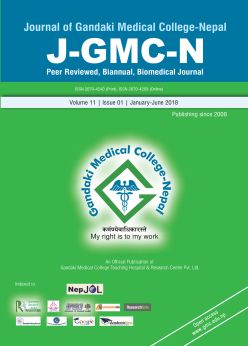Knowledge of Radiation Exposure and it Risk among Radiographers and Radio Technologists
DOI:
https://doi.org/10.3126/jgmcn.v12i2.27152Keywords:
Computed tomography (CT), Magnetic resonance imaging (MRI), Radiation, Ultrasound (USG)Abstract
Objective: The aim of this study was to assess the awareness, concern and practice on hazards of ionizing radiation and radiation protection among radiographers and technologists of Pokhara, Nepal and to evaluate the knowledge of radiation and its protection among them.
Materials and Methods: A validated questionnaire was used to collect data from radiographers and Technologists. The survey included multiple choice questions (MCQs) related to demographic characteristics (age, gender), academic qualification, and knowledge of radiation and radiation protection. Obtained data were analyzed using Statistical Package for Social Science (SPSS) version 25 software and shown in frequency, percentages.
Results: Among 103 participants, only 73.8% were NHPC registered and 46.7% had attended classes/seminar on the topic of radiation protection. Only 8.7% used dosimeters to measure the radiation dose. Among participants, 77.7% knew that annual whole-body dose for a radiation worker is 20 mSv and 87.4% knew that there should be distance of more than six feet from the X-ray tube while taking X-ray in the case of non-barrier protection. This study shows that the knowledge and the perceptions regarding radiation and its protection among the radiographers/technologist is just satisfactory and needs to be improved.
Conclusion: Overall awareness and knowledge of radiation protection and radiological procedures of radiologic technologist were satisfactory. However, there were some question that they needed mandatory training and knowledge. Therefore, we recommend that further workshops, seminars, symposium, training courses and Continuing Medical Education (CME) programs are recommended on a regular basis in collaboration with ISSRT and other national and international organizations to raise the level of radiation awareness.
Downloads
References
Bushberg, JT, Seibert JA, Edwin ML, Boone MJ. Essential physics of medical imaging. 2nd edition. Philadelphia: Lippincott Williams and Wilkins; 2002.
Balsak II, Gunes G, ulutasdemir N. Knowledge, attitude and behavior of Radiology professionals about the harmful effects of radiation which is used for diagnosis. Electronic International Journal of Education, Arts, and Science (EUEAS). 2016;2(1):31- 51.
WHO. Scientific background in communication radiation risks in pediatric imaging information to support healthcare discussions about benefit and risk. 2016.
Mubeen SM, Abbas Q, Nisar N. Knowledge about ionizing and nonionizing radiation among medical students. Ayub Medical College, Abbotabad, Karachi, Pakistan. 2008; 20(1): 118-20.
Kang KW. History and organizations for radiological protection. J Korean Med Sci. 2016 Feb; 3 (Suppl):S4-S5.
Rslanog˘lu A, Bilgin S, Kubalı Z, Ceyhan MN, Ilhan MN, Maral I. Doctors’ and intern doctors’ knowledge about patients’ ionizing radiation exposure doses during common radiological examinations. Diagn Interv Radiol. 2007;13:53-5.
Portelli JL, McNulty JP, Bezzina P, Rainford L. Paediatric imaging radiation dose awareness and use of referral guidelines amongst radiology practitioners and radiographers. Insights Imaging. 2016;7(1):145–53.
Rassin M, Granat P, Berger M, Silner E. Attitude and knowledge of physicians and nurses about ionizing radiation. Journal of Radiology Nursing. 2005;24:26- 30.
Ramanathan S, Ryan J. Radiation awareness among radiology residents, technologists, fellows and staff: where do we stand? Insights Imaging.2015;6:133-9.
Brenner DJ, Doll R, Goodhead DT, Hall EJ, Land CE, Little JB, et al. Cancer risks attributable to low doses of ionizing radiation: assessing what we really know. Proc Natl Acad Sci. USA. 2003 Nov;100(24):13761-6.
Karjodkar F. Textbook of Dental and Maxillofacial Radiology. 2nd edition. New Delhi: Jaypee Brothers; 2011.
Statkiewicz-Sherer MA, Visconti PJ, Ritenour ER, Haynes K. Radiation protection in medical radiography. 6th ed. St. Louis: Mosby; 2018.
Sarman I, Hassan DH. Factors affecting radiographers’ compliance with radiation protection on all areas of Hospital settings Worldwide-A meta analysis. International Journal forInnovative Research in Science & Technology. 2016 Sep;3(4):433-8.
Yurt A, Çavuşoğlu B, Günay T. Evaluation of awareness on radiation protection and knowledge about radiological examinations in healthcare professionals who use ionized radiation at work. Molecular Imaging and Radionuclide Therapy. 2014 Jun;23(2):48.
Downloads
Published
How to Cite
Issue
Section
License
This license allows reusers to distribute, remix, adapt, and build upon the material in any medium or format for noncommercial purposes only, and only so long as attribution is given to the creator.




